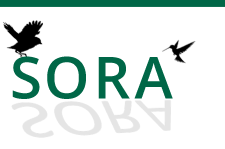Abstract
Los estudios dirigidos a caracterizar la avifauna asociada a morichales en Venezuela son pocos. El objetivo del presente trabajo fue caracterizar de manera preliminar la avifauna de un morichal del sur de Venezuela, a través de observaciones de campo y capturas con redes, tomando en cuenta su riqueza específica, composición de especies y estructura trófica. La riqueza específica alcanzó 59 especies, de las cuales tres representan nuevos registros para los morichales en Venezuela: el Playerito Solitario Tringa solitaria, el Martín Pescador Matraquero Chloroceryle amazona y el Canario de Sabana Sicalis columbiana. Cuatro especies fueron migratorias: el Playero Coleador Actitis macularius, el Playero Solitario, la Reinita de los Charcos Parkesia noveboracensis (boreales) y el Atrapamoscas Tijereta Tyrannus savana (austral). No hubo registros de aves endémicas, pero dos se consideran casi amenazadas según los criterios de conservación de Venezuela: el Tarotaro Cercibis oxycerca y la Cigüeña Ciconia maguari. Las aves registradas se incluyeron en nueve gremios tróficos, de los cuales los consumidores de invertebrados fueron los mejor representados con el 30% de las especies registradas. Los datos obtenidos revelan la importancia del morichal estudiado en la conservación de la avifauna local e intercontinental como hábitat para aves residentes y migratorias, algunas incluso bajo régimen especial de conservación.
Morichal environments are plant communities were the Moriche palms Mauritia flexuosa are noticeable. Studies focused on the avifauna associated these environments in Venezuela are few. This work is a preliminary description of the birdlife present in a morichal area from southern Venezuela. The morichal richness, community composition, and trophic structure was determined through field observations and mist-netting captures. Bird richness reached 59 species, with three new bird records for Venezuelan morichal enviroments: the Solitary Sandpiper Tringa solitaria, the Amazon Kingfisher Chloroceryle amazona, and the Orange-fronted Yellow Finch Sicalis columbiana. Also, four species were migratory: the Spotted Sandpiper Actitis macularius, the Solitary Sandpiper, the Northern Waterthrush Parkesia noveboracensis (boreal), and the Fork-tailed Flycatcher Tyrannus savana (austral). There was no records of endemic birds, but two birds recorded are considered almost endangered species according the conservation criteria in Venezuela: the Sharp-tailed Ibis Cercibis oxycerca, and the Maguari Stork. Recorded birds were allocated in nine feeding guilds, from which the consumers of invertebrates were the trophic group best represented (30% of the total bird recorded). The collected data highlights the importance of the morichal studies in bird conservation, including local and migratory species, some of them even under special conservation regimen.
Creative Commons License
Recommended Citation
Malavé-Moreno, Vicky C. and Cabrera, Hillary
(2018)
"Avifauna asociada a un área de morichales aledaña al río Caura, estado Bolívar, con nuevos registros de aves para los morichales de Venezuela / Avifauna Associated to a Morichal Environment from Caura River Area, Bolívar State, with New Records of Bird Species for the Morichal Environments of Venezuela,"
Revista Venezolana de Ornitología: Vol. 8
:
Iss.
1
, Article 1.
Available at:
https://digitalcommons.usf.edu/rvo/vol8/iss1/1

